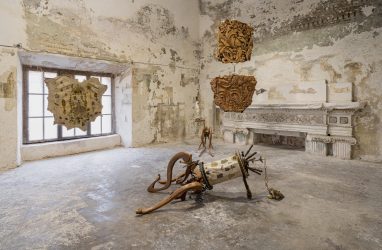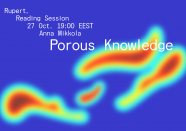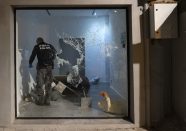 |
Newsletter |
 Whilst observing the vista of falling golden leaves, inhaling the scent of mildly decaying organic matter on the forest floor and blasting Vivaldi’s good-old Four Seasons in my earphones, I am happy to affirm that this is the time of harvest. Autumn is a busy period at Rupert and many things are happening, including Federico Campagna’s lecture Home and Monica Mays’s exhibition Bucolic Gang as part of our Public Programme, as well as the announcement of the selected participants for the 2022 residency programme, just to name a few. The transition of seasons alludes to thoughts about the future at the end of the world or that which constructs our realities and how (much) we are in charge of it. And while contemplating these questions, it is enriching to listen to Federico Campagna’s lecture, during which he elaborates on the notion of domesticity and home as a portal towards understanding complex realities. Federico’s lecture stems from his ongoing research and conversation with the artist Monica Mays about her exhibition Bucolic Gang. Bucolic Gang is the aftermath of Monica’s residency at Rupert in 2020. During this time, she foraged in local areas for various greenery, acquired leather sheets from an abandoned Soviet factory and gathered discarded household objects from around Vilnius, among many other things. As Monica mentioned during the exhibition’s opening, she is interested in the idea of duality that is embedded in the history and essence of these objects and in them becoming part of the sculptures in Bucolic Gang. Configurations of found objects and Monica’s newly produced forms emerge as sculptures, as something completely different and mutated from their origins — a flawed pearl, if you like. Talking of flawed pearls, the Baroque (or Neo-Baroque) period was another underlying tone in the exhibition, even reverberating in the choice of its location of the Baroque Church of Saint Virgin Maria in Vilnius. The church is also flawed but in its own way: its main altar is divided in half by a concrete floor (during Soviet times this space was turned into a warehouse) and the frescoes, presumably once lavish, now remain as ghostly fractions of imagery. Another stratum of the exhibition is anamorphosis which, in the context of the exhibition, is only used as a metaphor to observe the complexity of realities, be it the exhibition’s or our own. In the hope of these beautiful, organic encounters and their outcomes, it truly is a joy to announce Rupert’s 2022 residents. Among them are international artists, curators, writers and other interdisciplinary researchers: Andrius Arutiunian, Boz Deseo Garden, Danae Io, Davinia-Ann Robinson, Drew Zeiba, Gillies Adamson Semple, Isabella Benshimol Toro, Kyung Bin Koh, Lynton Talbot, Mika Hayashi Ebbesen, Mike Sperlinger, Murat Adash, Omsk Social Club, Philip Coyne, Ricki Dwyer, Sam Williams, Sarah Friend, Yassmin Abdel-Magied and Yen Chun Lin (as part of the collective ‘Yen + Here’). Residents will be working on their independent projects while getting to know the local cultural context, art institutions, other practitioners and audiences. We very much look forward to welcoming you to Vilnius! Truly yours,
|
 Rupert's Reading SessionsEvery month, a member of Rupert’s team or an invited guest selects material to discuss. The reading sessions are open to anyone by registration.  New 'Open Studio' episode with Miriam NaehMiriam Naeh is a London-based multi-disciplinary artist whose work is deeply influenced by human practice of storytelling. In her installations-as-narratives, she combines Middle Eastern mythology, post-humanist thought, humor, and personal experiences. This mixture produces de-centralized experiences, where the viewer is invited to participate in a quasi-mythological story, at the same time creating it and giving it particular meaning. Miriam combines a variety of media in her work and is particularly interested in the binaries of the real versus fictional, natural versus artificial. She invites the viewer to explore this ambiguous world where grotesque meets fragility and laughter meets “the sad sublime”. Listen here. |
